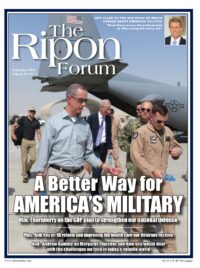
Fifteen years ago, the U.S. military was called into action after the devastating attacks on September 11. The enemy was capable and committed, but hard to find and finish. Today, while the fight against Islamist terrorists remains a serious challenge, the U.S. also faces nations that are acting more like capable adversaries than potential allies. On top of all that, the U.S. military is getting older, smaller, and weaker.
The growing threats against U.S. interests are familiar to many Americans. We’ve seen Russia’s aggressive actions in Ukraine, and China’s illegal islands in the South China Sea. We know that regardless of the nuclear deal, Iran will continue funding terrorist organizations and pursuing weapons that threaten the United States and our allies. North Korea has combined intercontinental ballistic missiles with its nuclear weapons, and is now also pursuing submarine-launched ballistic missiles. Added to all this is the growing danger of cyber-attacks and the persistent threat of terrorism.
At the same time, many Americans are not aware of the problems facing the U.S. military. Before 9/11, the military was shrinking and the defense budget was small. As the fight against terrorism ramped up, so did defense budgets, but the vast majority of that funding went to fight the wars in Iraq and Afghanistan, not to update or improve the U.S. military. Even after U.S. engagement is the Middle East declined, the military had little time to reset and recover. Since the Budget Control Act was passed in 2011 the defense budget has been cut by 25 percent in real terms, even as operations in Afghanistan and elsewhere continue. We now face a potentially deadly storm of rising threats, major ongoing operations, and dramatic defense budget cuts.
We now face a potentially deadly storm of rising threats, major ongoing operations, and dramatic defense budget cuts.
The problems facing the U.S. military are in three main areas. A strong military, just like a good police department or a winning sports team, is built on three basic building blocks: equipment, training, and size. A police department without good equipment, like the right police cars or bulletproof vests, will struggle to protect its community. A football team that never trains – never throws the ball or runs plays – will struggle to win. And any organization, from a kid’s soccer team to the U.S. military, will struggle if it is not big enough to play the game or meet the mission. Unfortunately, in all three areas – equipment, training, and size – the U.S. military is struggling.
The U.S. military’s warfighting equipment today was largely designed and built during the Cold War. During the 1990’s, investments in modernizing the military were minimal. In the following decade, funding for ongoing conflicts did not leave much room in the budget for modernization, and some major modernization efforts, like the Army’s Future Combat System, did not produce results. Today, that lack of modernizing means that the Air Force’s main bomber fleet averages 53-years old and its main aerial refueling tankers entered the fleet in 1956. And the other military services have similarly old, sometimes even antiquated, equipment.
Sadly, the U.S. military’s training situation may be even worse than its equipment situation. During the last fifteen years, the U.S. military understandably focused on training for the fight against terrorists and insurgencies. While the military dramatically improved its ability to fight these low-end threats, it came at the expense of preparing to fight potential high-end adversaries like Russia or China. Soldiers were preparing to fight poorly trained, equipped, and organized insurgencies, not large-scale ground combat against capable adversaries. Air Force pilots were training to bomb caves, not defeat sophisticated air defenses. Marines were driving through deserts in MRAPs, not practicing amphibious assaults. Today, the Secretary of the Air Force says that less than one-half of Air Force squadrons are ready for a high-end fight, the Chief of Staff of the Army says that one-third of his brigades are ready for a high-end fight, and the Navy and Marine Corps are struggling to keep their ships and units trained and maintained.
On top of old equipment and poor training, the U.S. military has become historically small. For many decades, the U.S. military was designed to be large enough to fight one war while maintaining the ability to deter opportunistic adversaries from threatening U.S. interests elsewhere. This two-conflict concept was supported across numerous administrations of both parties and served the U.S. well. Today, the U.S. military is barely large enough to win one major conflict. The Army is at 31 combat brigades instead of the 50 needed for two conflicts. The Navy is at 276 ships far short of the recommended 350. The Marine Corps is at 23 battalions instead of 36. The Air Force has a large number of aircraft, but many of them are outdated and approaching the end of their usefulness.
Today, the U.S. government spends a smaller portion of the federal budget on defense than it did before 9/11.
At a time of growing threats, the U.S. military is older, smaller, and weaker, but this can be turned around. The most important step is increasing the defense budget. Today, the U.S. government spends a smaller portion of the federal budget on defense than it did before 9/11. And as a percent of GDP, defense spending is well below the 40 year average. A group of outside bipartisan experts has recommended that the minimum the U.S. should spend on defense should be based on former Secretary of Defense Robert Gates’ last budget. For fiscal year 2017, that level would be almost $100 billion more than President Obama’s request.
With greater funds available for defense, Congress and the Administration can then start repairing the three basic building blocks: equipment, training, and size. The House versions of the fiscal year 2017 defense policy and defense funding bills take steps in the right direction, but more must be done. With all three critical areas, rebuilding will be measured in years, so the process should be started as soon as possible.
As threats grow, providing for the common defense should be the federal government’s top priority. Congress and the Administration should work together to increase the defense budget so that the U.S. military can start modernizing its equipment, increasing its training, and growing its size.
Justin T. Johnson specializes in defense budgets and policies for The Heritage Foundation’s Allison Center for National Security and Foreign Policy.




